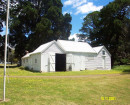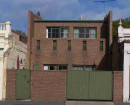UNDERGROUND PUBLIC TOILETS
ELIZABETH AND VICTORIA STREETS MELBOURNE, MELBOURNE CITY
-
Add to tour
You must log in to do that.
-
Share
-
Shortlist place
You must log in to do that.
- Download report
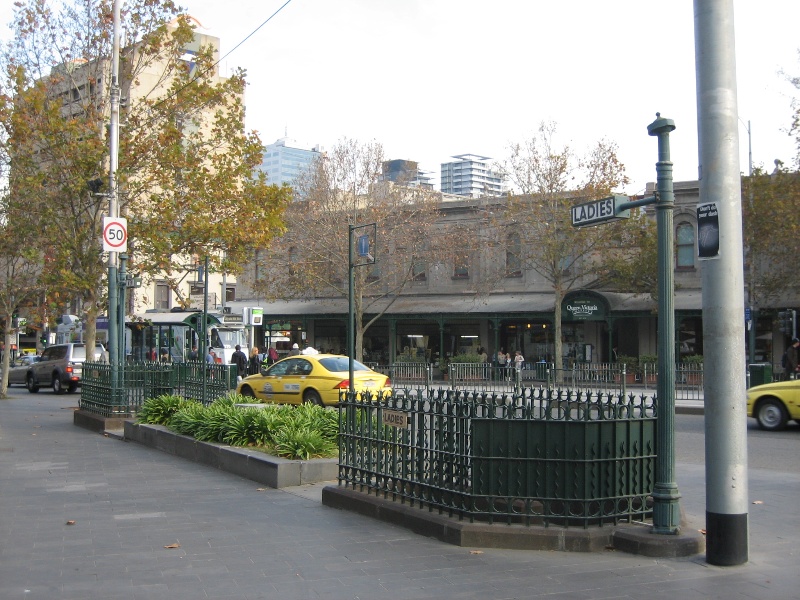

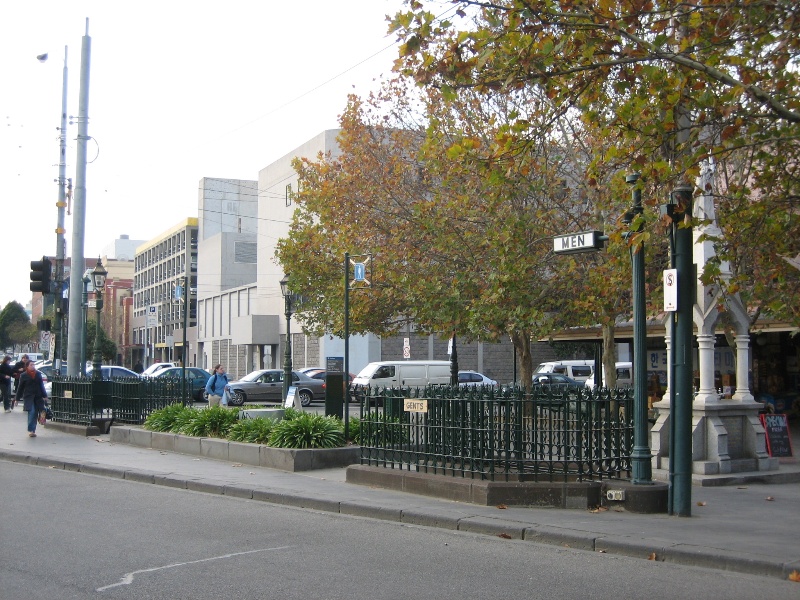
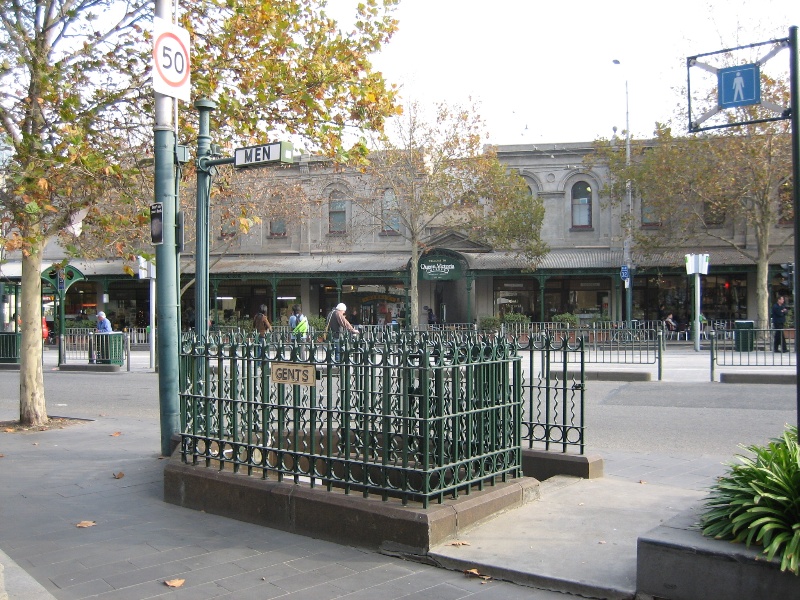

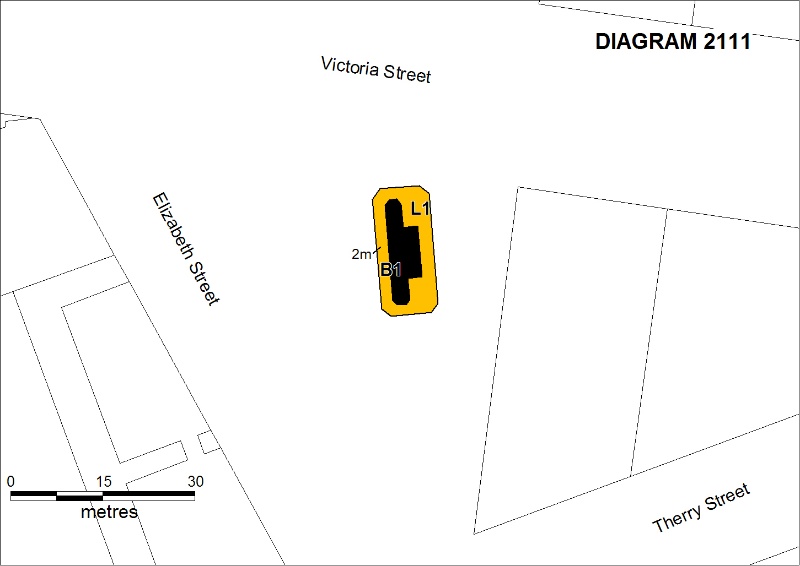
Statement of Significance
What is significant?
The underground public toilet near the corner of Elizabeth and Victoria Streets, built in 1907, is one of a group of such facilities built in Melbourne in the early twentieth century in response to increasing demand for public toilet facilities in the city that were both sanitary and discreet. Until 1902 there were no public toilets for women and few for men. The first public toilet, a urinal for men only, had been built in 1859, following the opening of the Yan Yean water supply in 1858. But these street level toilets were regarded as indecently public, and without an underground sewerage system the waste discharged into the gutters. Underground toilets, which removed toilets from public view and so satisfied contemporary perceptions of decency, had already been built in Scotland, England and Sydney. Such facilities were made possible in Melbourne by the establishment in December 1890 of the Melbourne & Metropolitan Board of Works, responsible for building and maintaining an underground sewerage system. The first underground public toilet in Melbourne, which was the first public toilet for women in the city, was opened in Russell Street in 1902, followed by another one for men in Queen Street in 1905. Public toilets for women were built only following concerted campaigns by feminist groups. The conveniences near the corner of Elizabeth and Victoria Streets included both men's and women's facilities, and was the second built in Melbourne for women and the third for men. It has been in continuous use since then.
The underground public toilet in Elizabeth Street near Victoria Street is opposite the Queen Victoria market. There is a stairway for each of the male and female toilets, at the top of which are wrought iron railings and gates, bluestone kerbing and cast iron sign posts, similar to the other underground toilets of the period. Below ground the female toilet measures 4.3m long and 3.8m wide and has three cubicles and two basins. The interior of the male toilet measures 5.1m long and 2.85m wide and has five cubicles, two basins and one urinal. The interiors have been remodelled and no original fittings have survived.
Why is it significant?
The underground public toilet in Elizabeth Street near Victoria Street is of historical and architectural significance to the state of Victoria.
How is it significant?
The underground public toilet in Elizabeth Street near Victoria Street has historical significance as one of the first underground public toilets in Melbourne. It was the second underground public toilet for women and the third for men in Victoria. It has significance for its association with issues of gender equality and the activities of the first-wave feminists in Victoria, as a reflection of an important era of sanitary, technological and social reform, and as a reflection of attitudes to public decency, in the early twentieth century. It is associated with a major engineering achievement, the development of Melbourne's underground drainage and sewerage system, and the advances in sanitation and public health made possible, following the establishment of the Melbourne Metropolitan Board of Works.
The underground toilet in Elizabeth Street is of architectural significance as an early example of an unusual building type, and of early twentieth century civic design. Although the interiors have been altered the remaining railings, gates and cast iron columns are of interest as examples of street furniture of the period.
-
-
UNDERGROUND PUBLIC TOILETS - History
Until the latter part of the nineteenth century very limited public toilet facilities were available in Melbourne. Before 1859 public toilets were only available in hotels, and men often needed to relieve themselves in the city's laneways. Women faced even more severe problems, as it was not considered respectable for them to enter hotels. Public urination was a greater problem in the vicinity of restaurants or theatres, the Bourke Street East theatre precinct being particularly notorious. The local Board of Health had noted in 1856 that the lack of public toilets needed to be resolved and with the opening of the Yan Yean water supply in 1858, the necessary infrastructure was starting to be put in place.
The first urinals were placed directly over gutters, and the waste washed into the Yarra. Melbourne's first public toilet was built by the Melbourne City Council on the pavement in Bourke Street near Elizabeth Street in April 1859 (Argus, 14 April 1859). No public facilities were available at that time for women. With developments in sanitation in other Australian cities and throughout Europe there was soon pressure to improve the rudimentary urinals. By 1888 Adelaide had a full sewage system in operation and Sydney's system was well on the way. In December 1891 the Melbourne Metropolitan Board of Works was established with responsibility for establishing sewerage services to the City of Melbourne.
By 1879 however there were only a few public urinals left in the city, due to the numerous complaints received by the MCC, reflecting current concerns for public health as well as changing ideas of privacy. The solution was to move public toilets underground, out of the public gaze. The Australian Ironmonger had discussed the underground conveniences in London, and said that they 'offer as efficient a solution of the problem as it is possible to conceive'. This publication highlighted the need for an underground sewerage system in Melbourne, concluding that 'till then the present showy structures must be endured'. The stink of urine in the back lanes continued to be one of the ubiquitous smells of nineteenth century Melbourne.
Melbourne's Town Clerk and City Surveyor had obtained details of underground toilets in Aberdeen, London, Leeds and Bournemouth. When in 1895 he was sent the plans of the underground toilets in Aberdeen, the correspondent, the Hon Edward Langton, described Melbourne's above ground urinals as 'relics of a barbarous age'. There was an acceptance that underground toilets were needed in the city: Sydney had established underground conveniences by 1888, but Melbourne had to wait until the MMBW could provide the necessary infrastructure.
The first underground public toilet, with facilities for both men and women, was opened in Russell Street just south of Bourke Street on 23 June 1902. It was designed by Adrian C Mountain, the Melbourne City Surveyor. Until then Melbourne had no public toilets for women, who had to make do with a few semi-private toilets at the railway station, markets and department stores, and public facilities were only built following a sustained campaign. In 1887 the Central Board of Health had suggested that there was a need for facilities for women in the city. In 1899 the Women's Political and Social Crusade (WPSC) petitioned the MCC and in the following year the MCC resolved to provide female sanitary conveniences in the city, but were slow to take action. Throughout 1901 both the Australian Health Society and the Women's Health Society wrote to the MCC. Mrs Catherine Rickarby was perhaps the most persistent campaigner. In January 1900 she wrote that 'thousands of women and children suffer in their visits to the city', whilst the men are 'lavishly provided for everywhere publicly and privately'; in December 1900 she wrote 'I have been calling attention to this subject for years, and no notice is taken, but men's wants are attended to without being asked for'.
The first public toilet for women was opened in the same year that they gained the right to vote and sit in Federal Parliament, and reflects the increased involvement by women in social and political life, and the movement of women from the private to the public sphere of city life. The involvement of the Women's Political and Social Crusade also demonstrates close links between the call for more underground public toilets and women's suffrage. Vida Goldstein was the President of the WPSC and one of Victoria's most prominent first wave feminists who stood as an independent for the Senate in 1903.
A second underground public toilet for men was built in 1905 in Queen Street at the intersection with Collins Street. There was widespread opposition to this, as it was situated at the centre of Melbourne's business district, demonstrating that even when located underground, public toilets continued to challenge notions of public respectability in the early twentieth century. The council defended the central location of the toilets, arguing that this was where such facilities were most needed.
It was not until 1907 that the second facility for women was opened, which was the third for men, in Elizabeth Street opposite the Victoria Market.
Several more such underground facilities were built by the City of Melbourne before World War II: a men's at the corner of Swanston and Little Collins Streets (1909, removed c1960); a men's in Elizabeth Street outside the GPO (1910), with a women's added here later (c1927); a women's in Collins Street beneath the Town Hall (1914), with a men's was added later (c1960); and another men's in Flinders Street opposite the end of Elizabeth Street (1918). By 1911 there were five underground toilets in Melbourne (Russell Street, Queen Street, Victoria Market, Swanston Street, GPO) three of which were for men only. Several more were built by the City of Melbourne in the inter-war period, all outside the centre of the city: in Carpentaria Place (now Gordon Reserve), East Melbourne (c1924: MCC plans from this year are labelled 'Proposed Women's Under-Ground Conveniences'); at the corner of King and Errol Streets, North Melbourne (designed 1938, now covered); at the corner of Faraday and Lygon Streets, Carlton (designed 1939); and in Parliament Place, East Melbourne (1939, now demolished). All of these except the one in Parliament Place had a similar above-ground form, with the stair entrances enclosed by an iron railing and gate. After World War II facilities were generally built at ground level. While they were originally built underground in response to contemporary standards of decency, which regarded underground toilets as more private and respectable than those in public view, modern users have different ideas about public decency, but consider facilities out of sight to be less safe.
UNDERGROUND PUBLIC TOILETS - Assessment Against Criteria
a. The historical importance, association with or relationship to Victoria's history of the place or object
The underground public toilet in Elizabeth Street near Victoria Street reflects an important era of technological and social change in Victoria. Underground public toilets were made possible by the creation of the MMBW in 1890 and the development of an underground water and sewerage system in Melbourne, a major advance in sanitation and public health in the state. This is significant as only the second public toilet for women in Victoria. The construction of public toilet facilities for women in the city, which acknowledged that women were not necessarily confined to the home, was only achieved following action by such feminist groups as the Women's Political and Social Crusade (WPSC), and of individuals such as Vida Goldstein and Catherine Rickarby.
b. The importance of a place or object in demonstrating rarity or uniqueness
The underground public toilet in Elizabeth Street near Victoria Street was the third of an important group of underground public toilets built in Melbourne in the early twentieth century. It was only the second public toilet built for women in Australia. It is one of the state's oldest public toilets, and is one of a group of such facilities which is unique in Australia.
c. The place or object's potential to educate, illustrate or provide further scientific investigation in relation to Victoria's cultural heritage
N/A
d. The importance of a place or object in exhibiting the principal characteristics or the representative nature of a place or object as part of a class or type of places or objects
The underground public toilet in Elizabeth Street is one of a group of eleven such facilities built by the Melbourne City Council between 1902 and 1939. All have similar features, with stairs surrounded by a wrought iron railing and gate leading down to an underground convenience. They are early examples of an unusual building type, and of early twentieth century civic design.
e. The importance of the place or object in exhibiting good design or aesthetic characteristics and/or in exhibiting a richness, diversity or unusual integration of features
N/A
f. The importance of the place or object in demonstrating or being associated with scientific or technical innovations or achievements
The underground public toilet in Elizabeth Street near Victoria Street is directly associated with a major advance in sanitation and public health in Victoria: the development of proper systems for water supply, drainage and sewerage, made possible by the creation of the MMBW in 1890.
g. The importance of the place or object in demonstrating social or cultural associations
The underground public toilets in Elizabeth Street near Victoria Street demonstrate important changes in ideas of acceptable public behaviour and perceptions of public decency during the twentieth century. The ground level public urinals erected during the nineteenth century were considered too public and undignified, and had been the subject of public complaints: underground facilities were seen as a partial solution to this problem. However following World War II attitudes to public decency changed and issues of safety became more important and few underground public toilets were built. Public toilets for women demonstrate the changing status of women and changing ideas of women's role in society in the early twentieth century. Public facilities such as these gave women a new freedom to move, work and socialise in the public sphere.
h. Any other matter which the Council deems relevant to the determination of cultural heritage significance
N/A
UNDERGROUND PUBLIC TOILETS - Plaque Citation
Built in 1907 this was one of eleven underground toilets built in Melbourne in the early twentieth century, and reflects an important era of sanitary and technological reform, and contemporary attitudes to public decency.
UNDERGROUND PUBLIC TOILETS - Permit Exemptions
General Exemptions:General exemptions apply to all places and objects included in the Victorian Heritage Register (VHR). General exemptions have been designed to allow everyday activities, maintenance and changes to your property, which don’t harm its cultural heritage significance, to proceed without the need to obtain approvals under the Heritage Act 2017.Places of worship: In some circumstances, you can alter a place of worship to accommodate religious practices without a permit, but you must notify the Executive Director of Heritage Victoria before you start the works or activities at least 20 business days before the works or activities are to commence.Subdivision/consolidation: Permit exemptions exist for some subdivisions and consolidations. If the subdivision or consolidation is in accordance with a planning permit granted under Part 4 of the Planning and Environment Act 1987 and the application for the planning permit was referred to the Executive Director of Heritage Victoria as a determining referral authority, a permit is not required.Specific exemptions may also apply to your registered place or object. If applicable, these are listed below. Specific exemptions are tailored to the conservation and management needs of an individual registered place or object and set out works and activities that are exempt from the requirements of a permit. Specific exemptions prevail if they conflict with general exemptions. Find out more about heritage permit exemptions here.Specific Exemptions:The purpose of the permit exemptions is to allow works that do not impact on the heritage significance of the place to occur without the need for a permit. Works other than those mentioned in the permit exemptions may be possible but will require either the written approval of the Executive Director or permit approval.
General Conditions:
1. All alterations are to be planned and carried out in a manner which prevents damage to the fabric of the registered place.
2. Should it become apparent during further inspection or the carrying out of alterations that originally or previously hidden or inaccessible details of the place are revealed which relate to the significance of the place, then the exemption covering such alteration shall cease and the Executive Director shall be notified as soon as possible.
3. If there is a conservation policy and plan approved by the Executive Director, all works will be in accordance with it.
4. Nothing in this declaration prevents the Executive Director from amending or rescinding all or any of the permit exemptions.
5. Nothing in this declaration exempts owners or their agents from the responsibility to seek relevant planning or building permits from the responsible authority where applicable.
Minor repairs and maintenance are exempt from permits, as is the removal of extraneous non-original items.
UNDERGROUND PUBLIC TOILETS - Permit Exemption Policy
The purpose of the Permit Policy is to assist when considering or making decisions regarding works to the place. It is recommended that any proposed works be discussed with an officer of Heritage Victoria prior to them being undertaken or a permit is applied for. Discussing any proposed works will assist in answering any questions the owner may have and aid any decisions regarding works to the place. It is recommended that a Conservation Management Plan is undertaken to assist with the future management of the cultural significance of the place.
The significance of the place lies in its rarity as one of the underground public toilets in Victoria. All of the remaining structures on Elizabeth Street, and the original volume of the toilets below ground, are integral to the significance of the place and any alterations that impact on their significance are subject to permit application. The addition of new structures may impact upon the cultural heritage significance of the place.
-
-
-
-
-
FORMER CARLTON AND UNITED BREWERY
 Victorian Heritage Register H0024
Victorian Heritage Register H0024 -
ROSAVILLE
 Victorian Heritage Register H0408
Victorian Heritage Register H0408 -
MEDLEY HALL
 Victorian Heritage Register H0409
Victorian Heritage Register H0409
-
'Aqua Profonda' sign wall sign, Fitzroy Swimming Pool
 Yarra City H1687
Yarra City H1687 -
'DRIFFVILLE'
 Boroondara City
Boroondara City -
1) WEATHERBOARD FARM HOUSE AND 2) THE OUTBUILDINGS
 Nillumbik Shire
Nillumbik Shire
-
-








